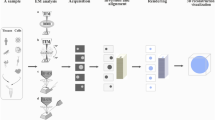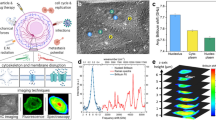Abstract
Confocal fluorescence microscopy enables visualisation and quantitation of fluorescent probes at high resolution deep within intact tissues, with minimal disturbance both of cell–cell interactions and the mechanical, ionic and physiological effects of the extracellular matrix. We illustrate the principles of multiple-parameter 3-D (x,y,z) imaging using reconstruction of nuclear channels in mammalian cells. Repeated sampling in time generates 4-D (x,y,z,t) images which can be used to follow dynamic changes, such as blue-light-dependent chloroplast re-orientation, in intact tissues. Quantitative measurements from multi-dimensional images require calibration of the spatial dimensions of the image and the fluorescence intensity response. This must be determined throughout the volume, which must be sampled to correct for geometric distortion as well as photometric errors arising from the complete optical system, including the specimen. The effects of specimen calibration are illustrated for morphological analysis of stomatal closing responses to abscisic acid in Commelina from 4-D images. Calibrated 4-D imaging allows direct volume measurements and we have followed volume regulation of chondrocytes in cartilage explants during osmotic perturbation. In intact cartilage, unlike in isolated cells, the chondrocytes exhibit volume regulatory mechanisms. In other cases, the fluorescence intensity of the probe may be related to a physiological parameter of interest and changes in its distribution within the cell. Optical sectioning permits discrimination of signal in separate compartments within the cell and can be used to follow transport events between different organelles. We illustrate 3-D (x,y,t) measurements of vacuolar glutathione conjugate pump activity in intact roots of Arabidopsis by following the sequestration of a fluorescent conjugate between glutathione and monochlorobimane. Dynamic measurements of protein localisation are now possible following the introduction of chimeric fusion proteins with green fluorescent protein (GFP) from Aequoria victoria. We have analysed the disposition of heterochromatin in nuclei of living Schizosaccharomyces pombe cells expressing a chimeric construct between Swi6 and GFP. Heterochromatin dynamics can be followed throughout mitosis in 4-D (x,y,z,t) images. Statistical analysis of the fluorescence histograms from each nucleus over time provides quantitative support for aggregation and dispersion of Swi6-GFP clusters during mitosis, rather than dissociation of Swi6 from the heterochromatin. A wide range of single-wavelength and ratio probes are available for imaging different ion activities. We compare 3-D (x,y,t) measurements of ion activities made using single-wavelength (Fluo-3 for calcium) and ratio (BCECF for pH) measurements, using stomatal responses in Vicia faba to peptides from the auxin-binding protein of maize and tip growth in pollen tubes of Lilium longiflorum as examples. Ratioing techniques have many advantages for quantitative fluorescence measurements and we conclude with a discussion of techniques to develop ratioing of single-wavelength probes against alternative references, such as DNA, protein or cell wall material.
Similar content being viewed by others
Abbreviations
- ABP1:
-
Auxin-binding protein from Zea mays
- BCECF:
-
[2’,7’- bis -(2- carboxyethyl)- 5-(and-6)- carboxyfluorescein], [Ca2+] cytoplasmic free calcium concentration
- CLSM:
-
confocal laser scanning microscopy
- CMFDA:
-
5-chloromethylfluorescein diacetate, Con-A concanavalin-A
- ER:
-
endoplasmic reticulum
- FC:
-
fusicoccin, Fluo-3 {1- [2-amino-5- (2,7- dichloro-6- hydroxy-3- oxy-9- xanthenyl)- phenoxy]-2- [2-amino-5- methylphenoxy] ethane-N,N,N’,N’- tetraacetic acid}
- FWHM:
-
full-width at half maximum
- GFP:
-
green fluorescent protein
- GS-B:
-
glutathione-bimane conjugate
- GSH:
-
glutathione
- GS-X:
-
any glutathione conjugate
- NA:
-
numerical aperture
- PI:
-
propidium iodide
- PSF:
-
point spread function, r.m.s. root mean square
- SBL:
-
strong blue light, s.d. standard deviation
- S/N:
-
signal-to-noise ratio
- WBL:
-
weak blue light
Author information
Authors and Affiliations
Corresponding author
Electronic supplementary material
Supplementary material (346 KB)
Supplementary material (239 KB)
Supplementary material (864 KB)
Supplementary material (527 KB)
Supplementary material (951 KB)
Supplementary material (504 KB)
Supplementary material (109 KB)
Supplementary material (969 KB)
Rights and permissions
About this article
Cite this article
Fricker, M.D., Chow, CM., Errington, R.J. et al. Quantitative imaging of intact cells and tissues by multi-dimensional confocal fluorescence microscopy. EBO 2, 1–23 (1997). https://doi.org/10.1007/s00898-997-0019-2
Received:
Accepted:
Issue Date:
DOI: https://doi.org/10.1007/s00898-997-0019-2




